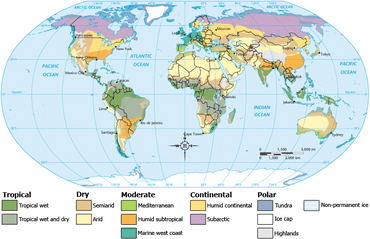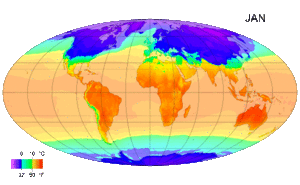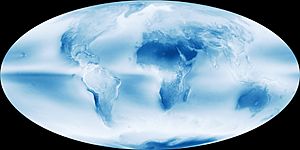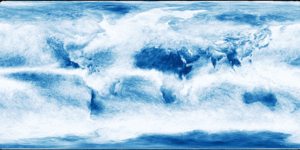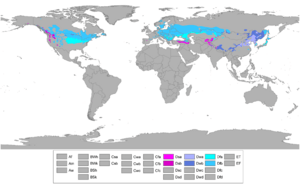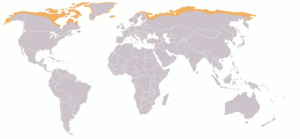Climate facts for kids
Climate means the usual condition of the temperature, humidity, atmospheric pressure, wind, rainfall, and other meteorological elements in an area of the Earth's surface for a long time. Climate is different from weather. Weather is the condition of these elements right now, for shorter periods of time that are up to two weeks.
The latitude, ground, and height can change the climate of a location. It is also important to note if oceans or other large bodies of water are nearby. Climates are most commonly classified by temperature and precipitation. The most commonly used classification was the Köppen climate classification, first made by Wladimir Köppen. The Thornthwaite system, which was used from 1948, not only uses temperature and precipitation information, but evapotranspiration too. This makes it useful for studying how many different kinds of animal species there are, and about the things that could happen when climates change. The Bergeron and Spatial Synoptic Classification systems focus more on where the air masses which help make climates come from.
Climate change
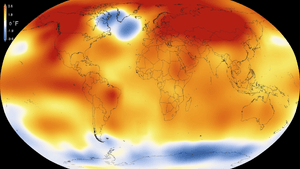
Climates can change after a long time. Recently, the world may be becoming warmer, as is discussed in global warming.
In recent usage, especially in the context of environmental policy, the term "climate change" often refers only to changes in modern climate, including the rise in average surface temperature known as global warming. In some cases, the term is also used with a presumption of human causation.
Climate change is the variation in global or regional climates over time. It reflects changes in the variability or average state of the atmosphere over time scales ranging from decades to millions of years. These changes can be caused by processes internal to the Earth, external forces (e.g. variations in sunlight intensity) or, more recently, human activities.
Climate models
The climate of a place is given names such as below:
- Rainforests are characterized by high rainfall, with definitions setting minimum normal annual rainfall between 1,750 millimetres (69 in) and 2,000 millimetres (79 in). Mean monthly temperatures exceed 18 °C (64 °F) during all months of the year.
- A monsoon is a seasonal prevailing wind which lasts for several months, ushering in a region's rainy season. Regions within North America, South America, Sub-Saharan Africa, Australia and East Asia are monsoon regimes.
- A tropical savanna is a grassland located in semiarid to semi-humid climate regions of subtropical and tropical latitudes, with average temperatures remain at or above 18 °C (64 °F) year round and rainfall between 750 millimetres (30 in) and 1,270 millimetres (50 in) a year. They are widespread on Africa, and are found in India, the northern parts of South America, Malaysia, and Australia.
- The humid subtropical climate zone where winter rainfall (and sometimes snowfall) is associated with large storms that the westerlies steer from west to east. Most summer rainfall occurs during thunderstorms and from occasional tropical cyclones. Humid subtropical climates lie on the east side of continents, roughly between latitudes 20° and 40° degrees away from the equator.
- A humid continental climate is marked by variable weather patterns and a large seasonal temperature variance. Places with more than three months of average daily temperatures above 10 °C (50 °F) and a coldest month temperature below −3 °C (27 °F) and which do not meet the criteria for an arid or semiarid climate, are classified as continental.
- An oceanic climate is typically found along the west coasts at the middle latitudes of all the world's continents, and in southeastern Australia, and is accompanied by plentiful precipitation year-round.
- The Mediterranean climate regime resembles the climate of the lands in the Mediterranean Basin, parts of western North America, parts of Western and South Australia, in southwestern South Africa and in parts of central Chile. The climate is characterized by hot, dry summers and cool, wet winters.
- A steppe is a dry grassland with an annual temperature range in the summer of up to 40 °C (104 °F) and during the winter down to −40 °C (−40 °F).
- A subarctic climate has little precipitation, and monthly temperatures which are above 10 °C (50 °F) for one to three months of the year, with permafrost in large parts of the area due to the cold winters. Winters within subarctic climates usually include up to six months of temperatures averaging below 0 °C (32 °F).
- Tundra occurs in the far Northern Hemisphere, north of the taiga belt, including vast areas of northern Russia and Canada.
- A polar ice cap, or polar ice sheet, is a high-latitude region of a planet or moon that is covered in ice. Ice caps form because high-latitude regions receive less energy as solar radiation from the sun than equatorial regions, resulting in lower surface temperatures.
- A desert is a landscape form or region that receives very little precipitation. Deserts usually have a large diurnal and seasonal temperature range, with high or low, depending on location daytime temperatures (in summer up to 45 °C or 113 °F), and low nighttime temperatures (in winter down to 0 °C or 32 °F) due to extremely low humidity. Many deserts are formed by rain shadows, as mountains block the path of moisture and precipitation to the desert.
See also: Köppen's climate classification scheme
See also
 In Spanish: Clima para niños
In Spanish: Clima para niños


